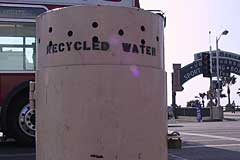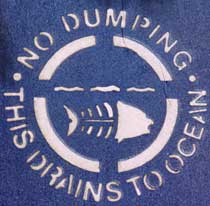
Water in Los Angeles
 Recycled water in use in Santa Monica |
Water, or lack of water, is one of the Los Angeles area's most notorious problems. Eighty percent of the water used by the city of L.A. is imported. The region has made great strides in water conservation, and now has one of the lowest rates of daily water use per person in the country. But it's not enough.
Increasing population is at odds with the region's decreasing ability to import more water, as other Western cities competing for water supplies grow and more water is earmarked for environmental restoration. Other cities across the country are now facing the same water shortages the Southland has faced for years.
"It happened to us first, and has since expanded to the rest of the US - last year 27 states were on drought alert," said Earle Hartling of the Sanitation Districts of Los Angeles County. "We've adapted to living with that, but our population is growing so much that we just don't have any other places to get unallocated raw water, so we have to use it twice."
To cope with the looming water crunch, Southern California is looking at other ways to come up with more water, including more wastewater recycling. Also known as water reclamation, some communities have done this for years on a limited scale, but it is rapidly expanding throughout the world. Irvine Ranch Water District is a leader in water reclamation.
"Southern California is head and shoulders above everyone else in terms of recycled water," said Bahman Sheikh of the WateReuse Association, an industry group.

|
Wastewater recycling is just what it sounds like - turning sewage into usable water. Sewage is 98% water, and only 2% other parts we don't like to think about. Though the concept makes some people cringe, most water recyclers take a pragmatic approach.
"All water is recycled -it's all dinosaur pee," said Hartling. "All the water we have now is all the water we've every had, every drop of water has gone through some animal's kidney, or thousands of animals."
The city and county of LA produce about one billion gallons of wastewater a day. Though it is possible, with much treatment, to turn wastewater into drinkable (potable) water, most recycling programs use the water for landscape irrigation or toilet flushing. In a city, about half of all water use is for irrigation.
Even in a region short of water, recycling can be a touchy political issue. Many people are worried that reusing water carries health risks, despite decades of studies showing no ill effects. A recent plan by the City of Los Angeles to use recycled water to replenish groundwater supplies in the San Fernando Valley was cancelled after a storm of controversy. Other reclaimed water projects have recently been scuttled by the public in Dublin/San Ramon, San Diego, Redwood City and the San Gabriel Valley.
Another big problem is water pollution. Most modern water pollution isn't due to spewing factories or sewage plants. It's from the oil, gas, pesticides, fertilizers and trash that wash off concrete roads and parking lots into storm drains and out to the Los Angeles River. Education programs are under way to warn people about the dangers of over-watering lawns, hosing off sidewalks and washing cars, but cities are facing staggering pricetags to clean up polluted waterways because of state and federal clean water regulations. Many are looking at methods of catching runoff water before it hits waterways. The city of Santa Monica has built a unique fix with the SMURRF.